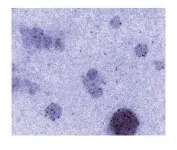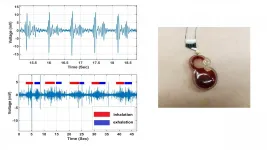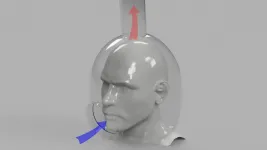(Press-News.org) Maunakea, Hawaii - The most distant quasar known has been discovered. The quasar, seen just 670 million years after the Big Bang, is 1000 times more luminous than the Milky Way, and is powered by the earliest known supermassive black hole, which weighs in at more than 1.6 billion times the mass of the Sun. Seen more than 13 billion years ago, this fully formed distant quasar is also the earliest yet discovered, providing astronomers with insight into the formation of massive galaxies in the early universe. The result was released today at the January 2021 meeting of the American Astronomical Society (AAS).
Quasars, which are powered by the feeding frenzies of colossal supermassive black holes, are the most energetic objects in the universe. They occur when gas in the superheated accretion disk around a supermassive black hole is inexorably drawn inwards, radiating light across the electromagnetic spectrum. The amount of energy emitted by quasars is enormous, with the most massive examples easily outshining entire galaxies.
At an AAS press conference today, January 12, 2021, an international team of astronomers announced the discovery of J0313-1806, the most distant quasar known to date with a redshift of z = 7.64.
The study, which includes data from several Maunakea Observatories in Hawaii - UKIRT, W. M. Keck Observatory, and the international Gemini Observatory, a Program of NSF's NOIRLab - as well as Pan-STARRS1, a survey telescope on Maui operated by the University of Hawaii Institute for Astronomy, has been accepted in The Astrophysical Journal Letters and is available in pre-print format on arXiv.org.
"The most distant quasars are crucial for understanding how the earliest black holes formed and for understanding cosmic reionization -- the last major phase transition of our universe," said Xiaohui Fan, study co-author and Regents Professor of Astronomy at the University of Arizona.
The presence of such a massive black hole so early in the universe's history challenges theories of black hole formation.
"Black holes created by the very first massive stars could not have grown this large in only a few hundred million years," says Feige Wang, NASA Hubble fellow at the University of Arizona and lead author of the research paper.
The observations that led to this discovery were made using a variety of observatories around the world, including several world-class telescopes in Hawaii.
Data from Pan-STARRS1 and the UKIRT Hemisphere Survey helped to first identify J0313-1806. Once the team confirmed its identity as a quasar, they obtained high-quality spectra from Keck Observatory and Gemini North to measure the mass of the central supermassive black hole.
"Measurement of spectral lines that originate from gas surrounding the quasar's accretion disk allows us to determine the black hole's mass and study how its rapid growth influences its environment. For such distant quasars, the most important spectral lines are redshifted to near-infrared wavelengths and Keck's NIRES spectrograph is an excellent instrument for these observations," said co-author Aaron Barth, a professor of Physics and Astronomy at the University of California, Irvine.
"Observing infrared light requires low temperatures. The near-freezing climate prevailing at the sky-scraping summit of Maunakea (13,796 ft or 4205 m) make it one of the only sites on Earth with instruments sensitive enough to observe such red wavelengths," said Joe Hennawi, a professor at UC Santa Barbara who helped execute the observations with the Keck/NIRES spectrograph.
In addition to weighing the monster black hole, the Keck Observatory and Gemini North observations uncovered an extremely fast outflow emanating from the quasar in the form of a high-velocity wind traveling at 20% of the speed of light.
"The energy released by such an extreme high-velocity outflow is large enough to impact the star formation in the entire quasar host galaxy," said co-author Jinyi Yang, Peter A. Strittmatter postdoctoral fellow of Steward Observatory at the University of Arizona.
This is the earliest known example of a quasar sculpting the growth of its host galaxy, making J0313-1806 a promising target for future observations.
The galaxy hosting J0313-1806's is undergoing a spurt of star formation, producing new stars 200 times faster than the Milky Way. The combination of this intense star formation, the luminous quasar, and the high-velocity outflow make J0313-1806 and its host galaxy a promising natural laboratory for understanding the growth of supermassive black holes and their host galaxies in the early universe.
"This would be a great target to investigate the formation of the earliest supermassive black holes," concluded Wang. "We also hope to learn more about the effect of quasar outflows on their host galaxy -- as well as to learn how the most massive galaxies formed in the early universe."
INFORMATION:
ABOUT NIRES
The Near Infrared Echellette Spectrograph (NIRES) is a prism cross-dispersed near-infrared spectrograph built at the California Institute of Technology by a team led by Chief Instrument Scientist Keith Matthews and Prof. Tom Soifer. Commissioned in 2018, NIRES covers a large wavelength range at moderate spectral resolution for use on the Keck II telescope and observes extremely faint red objects found with the Spitzer and WISE infrared space telescopes, as well as brown dwarfs, high-redshift galaxies, and quasars. Support for this technology was generously provided by the Mt. Cuba Astronomical Foundation.
ABOUT W. M. KECK OBSERVATORY
The W. M. Keck Observatory telescopes are among the most scientifically productive on Earth. The two 10-meter optical/infrared telescopes atop Maunakea on the Island of Hawai?i feature a suite of advanced instruments including imagers, multi-object spectrographs, high-resolution spectrographs, integral-field spectrometers, and world-leading laser guide star adaptive optics systems. Some of the data presented herein were obtained at Keck Observatory, which is a private 501(c) 3 non-profit organization operated as a scientific partnership among the California Institute of Technology, the University of California, and the National Aeronautics and Space Administration. The Observatory was made possible by the generous financial support of the W. M. Keck Foundation. The authors wish to recognize and acknowledge the very significant cultural role and reverence that the summit of Maunakea has always had within the Native Hawaiian community. We are most fortunate to have the opportunity to conduct observations from this mountain.
The American Society of Hematology (ASH), the International Society on Thrombosis and Haemostasis (ISTH), National Hemophilia Foundation (NHF), and World Federation of Hemophilia (WFH) have developed joint clinical practice guidelines on the diagnosis and management of von Willebrand Disease (VWD), the world's most common inherited bleeding disorder. The guidelines were published today in Blood Advances.
VWD affects approximately 1% of the world's population, and it is the most common bleeding disorder. Although VWD occurs among men and women equally, women are more likely to notice the symptoms because of heavy or abnormal bleeding during their menstrual periods and after childbirth. This inherited condition results in the ...
LA JOLLA, CALIF. - Jan 12, 2020 - Scientists at Sanford Burnham Prebys Medical Discovery Institute have identified the sensor in human lungs that detects SARS-CoV-2 and signals that it's time to mount an antiviral response. The study, published today in Cell Reports, provides insights into the molecular basis of severe disease and may enable new strategies for the treatment and prevention of COVID-19.
"Our research has shown that MDA-5 is the immune cop that's tasked to keep an eye out for SARS-CoV-2 and call for back-up," says Sumit Chanda, Ph.D., director of the Immunity and Pathogenesis Program at Sanford Burnham Prebys and senior author of the study. ...
Key Takeaways:
Machine learning can be an effective tool to set competitive prices.
Artificial intelligence has its limits on how to set the most effective prices due to variables beyond the seller's control.
Over the long term, supracompetitive pricing can result.
CATONSVILLE, MD, January 12, 2021 - Machine learning and artificial intelligence (AI) are perfectly suited to help companies and marketers monitor and set prices based on real-time dynamic pricing. But new research has identified some possible unintended consequences of AI in this area.
Machine learning algorithms don't always account for factors outside of the seller's control, such as competitor prices. Researchers ...
The daily toll of COVID-19, as measured by new cases and the growing number of deaths, overlooks a shadowy set of casualties: the rising risk of mental health problems among health care professionals working on the frontlines of the pandemic.
A new study, led by University of Utah Health scientists, suggests more than half of doctors, nurses, and emergency responders involved in COVID-19 care could be at risk for one or more mental health problems, including acute traumatic stress, depression, anxiety, problematic alcohol use, and insomnia. The researchers found that the risk of these mental health conditions was comparable to rates observed during natural disasters, such as 9/11 and Hurricane Katrina.
"What health care workers are experiencing is akin to domestic combat," says ...
LOS ANGELES (Jan. 11, 2021) -- Cell-derived exosomes are effective in treating disease when mixed with the dominant protein in breast milk and given orally, a new Smidt Heart Institute study of laboratory mice shows. The findings, published in the peer-reviewed Journal of Extracellular Vesicles, could help develop new oral medications for treating patients with muscular dystrophy and heart failure.
The study builds on more than a decade of research led by Eduardo Marbán, MD, PhD, executive director of the Smidt Heart Institute and Cedars-Sinai professor of Cardiology. The research has focused on human cardiosphere-derived ...
Most consumers of drinking water in the United States know that chemicals are used in the treatment processes to ensure the water is safe to drink. But they might not know that the use of some of these chemicals, such as chlorine, can also lead to the formation of unregulated toxic byproducts.
Johns Hopkins Environmental Health and Engineering Prof. Carsten Prasse proposes a new approach to assessing drinking water quality that could result in cleaner, safer taps.
"We are exposing people in the United States to these chemical compounds without knowing what they ...
During a typical year, over a million people visit Yellowstone National Park, where the Old Faithful geyser regularly blasts a jet of boiling water high in the air. Now, an international team of astronomers has discovered a cosmic equivalent, a distant galaxy that erupts roughly every 114 days.
Using data from facilities including NASA's Neil Gehrels Swift Observatory and Transiting Exoplanet Survey Satellite (TESS), the scientists have studied 20 repeated outbursts of an event called ASASSN-14ko. These various telescopes and instruments are sensitive to different wavelengths of light. By using them collaboratively, scientists obtained more detailed pictures of the outbursts.
"These are the most predictable and frequent recurring multiwavelength ...
WASHINGTON, January 12, 2021 -- A highly sensitive wearable sensor for cardiorespiratory monitoring could potentially be worn continuously by cardiac patients or others who require constant monitoring.
The small and inexpensive sensor, announced in Applied Physics Letters, by AIP Publishing, is based on an electrochemical system involving two ionic forms of iodine, I- and I3-. A solution containing these electrolyte substances is placed into a small circular cavity that is capped with a thin flexible diaphragm, allowing detection of subtle movements when placed on a patient's chest.
Small motions that arise from the heartbeat and breathing cause the flexible diaphragm ...
Stiffness in our tissues causes tension in our cells. Research from the Buck Institute, the University Health Network (University of Toronto), Stanford University, and the University of Alberta shows that stiffness impacts the innate immune system by upping its metabolism. The findings suggest the cellular tension likely sets off an inflammatory loop that contributes to the development of chronic diseases of aging. Publishing in Cell Reports, Buck Associate Professor Dan Winer, MD, and colleagues present an emerging way of looking at how the immune system functions, possibilities for new immunotherapeutics, and a call for scientists to reconsider the way they do research.
While stiffness ...
WASHINGTON, January 12, 2021 -- The risk of infection of COVID-19 is high for medical specialists who come in contact with symptomatic or asymptomatic patients. Dentists and otolaryngologists are at particular risk, since they need direct access to the mouth, nose, and throat of patients.
The current solutions, which include wearing N95 masks and face shields, clinic room evacuation, negative pressure rooms, and special air filtration systems, are expensive, not highly effective, and not very accessible.
In Physics of Fluids, by AIP Publishing, researchers at Cornell University discuss their design of an open-faced helmet for patient use ...




